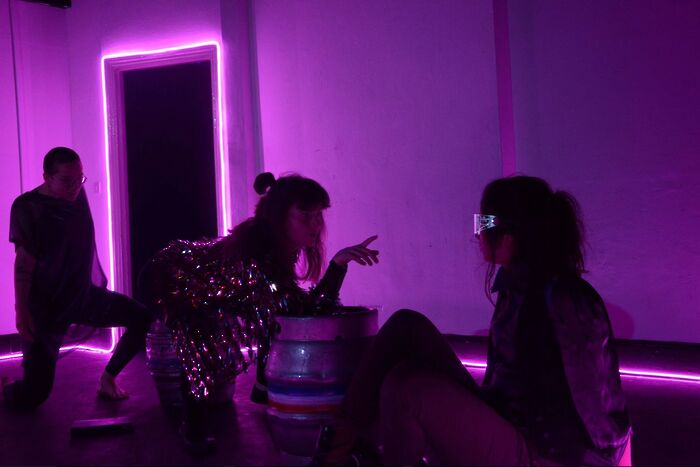In The Next Room (or The Vibrator Play): On Orgasms and Intimacy
Riona Millar explores how this week’s ADC main show tackles the history of vibrators and female sexuality

Sarah Ruhl’s 2009 play has two parts to its name: In the Next Room, or The Vibrator Play. Its two names cover the two parts of the play’s nature. Despite the humour inherent in a play centred around 1880s New York hysteria treatments which involve using vibrators to stimulate orgasms, or, as the play refers to them, paroxysms, this is a play that also deals with race and class, maternal affection, emotional intimacy, infidelity, and explorations of homosexual tensions between women.
It is not, however, a play that makes light of these things – the comedy of onstage orgasms is separate and distinct from moments where a woman grieves a lost child, or a wife is rejected by her husband. The balance of the passionate and the clinical is crucial to the play, felt most keenly in the two rooms referred to in the title, the medical room of Dr Givings, and the adjoining parlour in which his wife receives visitors. Almost all of the orgasms take place in the doctor’s surgery, so that we as an audience feel a distinct clinical separation from the moments of emotional and even sexual intimacy in the parlour.
A main challenge for cast and director alike has been the staging of the intimacy
Director Alex Ridley is a student of History and Philosophy of Medicine, focusing last year on the history of contraception, and the play’s scientific elements are what initially piqued her interest. The play uses an original, working vibrator from the 1920s that buzzes with a worrying ferocity when turned on, and is for the most part faithful to the history of the vibrator. Sarah Ruhl, the playwright, used historian Rachel P. Maines’ book The Technology of Orgasm to better understand the sexually charged (so to speak) history of electrical stimulation from the 1880s onwards, leading us to the vibrator that we have today. In one scene, Mrs Daldry, one of the doctor’s patients, asks if she might be able to purchase an at-home contraption, so that she might better continue her “treatments” herself.
As a matter of fact, women were able to purchase vibrators, marketed from the Sears catalogue up until the 1950s, when someone cottoned onto the fact that women were using them to achieve orgasms and not remove wrinkles or improve digestion, as they were intended to be used. Using a 1920s vibrator, therefore, feels like the production is keeping in good faith with Ruhl’s intentions, along with costume designer Valentin Foley’s beautiful 19th century dresses, complete with petticoats and interminable buttons.
A main challenge for cast and director alike has been the staging of the intimacy: from onstage orgasms to what is scripted as a full-frontal sex scene, intimacy direction has been at the forefront of the rehearsals. The rehearsal process in fact began with an orgasm workshop, plus an intimacy workshop for Oliver Jones and Mabel Hoskins, playing Dr and Mrs Givings respectively. To an extent, intimacy direction is not so different from fight choreography – it’s about making things as realistic as possible to an audience without making the actors uncomfortable.
Part of the way in which the actors are made comfortable is through the staging of orgasms in the play itself. They are almost all entirely clinical and scientific, performed by Dr Givings or his assistant Annie with a total disinterest in proceedings; they have the same sexual charge as a prostate exam. The presentation of orgasms as a satisfying result to a clinical procedure means that the actors can disengage from such an intimate moment and keep it within the context of the doctor’s surgery.
This separation of orgasm and intimacy is a very important dynamic in the play. The manifestation of the separate rooms in the set, signalled by the doctor’s surgery in apposition to his wife’s parlour, sets the tone for the Victorian upper middle class ideals of affection. The artist, Leo, who is also being treated for hysteria (a rare but real phenomenon), stands as a direct parallel to the impassive doctor, and presents both Mrs Givings and the audience with a sense of the alternative possibilities in intimacy. Indeed in the last scene of the play, when we finally get to see some of Dr Givings’ vulnerability, it is one of the most tender moments in the whole play.
 News / Downing investigates ‘mysterious’ underground burial vault 29 December 2025
News / Downing investigates ‘mysterious’ underground burial vault 29 December 2025 News / Unions protest handling of redundancies at Epidemiology Unit30 December 2025
News / Unions protest handling of redundancies at Epidemiology Unit30 December 2025 Lifestyle / Ask Auntie Alice29 December 2025
Lifestyle / Ask Auntie Alice29 December 2025 Interviews / You don’t need to peak at Cambridge, says Robin Harding31 December 2025
Interviews / You don’t need to peak at Cambridge, says Robin Harding31 December 2025 Features / ‘Treated like we’re incompetent’: ents officers on college micromanagement30 December 2025
Features / ‘Treated like we’re incompetent’: ents officers on college micromanagement30 December 2025









